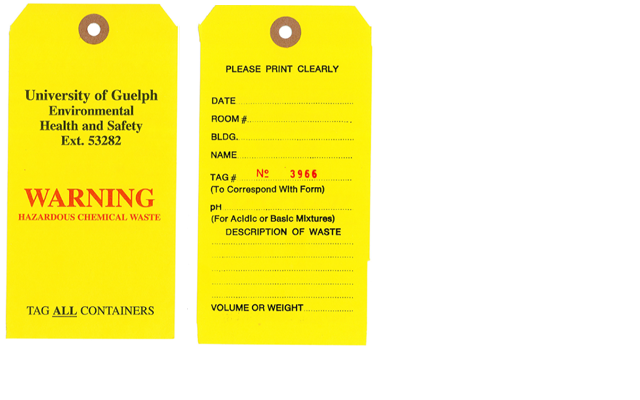Hazardous Waste
NEW - Chemical hazardous disposal requests can now be submitted electronically
Chemical Hazardous Waste Disposal request submission process.
Your waste disposal request will be automatically sent to EHS with a copy to your own email for your records. Please submit your chemical waste disposal request by 12 am on Sundays. Should you have any questions, please email Sr. H&S Consultant (Laboratory) at: lso@uoguelph.ca.
Hazardous Waste
What do labs, vehicle services, and maintenance departments have in common? - They all generate hazardous waste.
Hazardous waste disposal is subject to municipal, provincial and federal regulations that govern:
- What waste is classified as hazardous;
- How it can or cannot be disposed of;
- Transport of the waste; and
- Documentation required for transfer, treatment and disposal of waste
The hazardous waste management program is available at Hazardous Management Program. Poster for proper waste segregation is available at Waste Segregation Matrix.
In order to ensure that hazardous waste disposal for the end user is convenient and simple, and to ensure that all required legislation is adhered to, hazardous waste removal for Main Campus has been centralized and is managed through the Environmental Health and Safety department.
Hazardous wastes regularly picked up across campus include:
- Chemical (e.g. corrosives, reactives, flammables, toxic materials, leachate toxic materials)
- Radioactive
- Sharps (e.g. blades, needles, contaminated broken glass)
- Batteries (e.g. alkaline, Ni-Cad, lead-acid)
- Bulbs (e.g. fluorescent, metal halide, sodium vapour - does not include incandescent which are non-hazardous)
Hazardous Waste Disposal Procedure (Guelph Campus)
- Package the waste
- Label with yellow hazardous waste tag
- Store safely in your lab or workplace
- Complete and submit a waste disposal request form
How do I prepare the waste for disposal?
Packaging
You are responsible for providing appropriate waste containers as well as ensuring that all hazardous waste is packaged and labelled appropriately. The safety of the hazardous waste contractors depends on the waste containers maintaining their integrity and the waste being accurately identified. The following are packaging requirements:
- Containers are to be in good condition.
- Incompatible materials are not to be combined in a single waste container.
- Chemical liquid waste containers are not to be filled beyond approximately 75% of their capacity to allow for vapour expansion.
- Container materials must be compatible with the contained wastes (e.g. hydrofluoric acid cannot be stored in glass containers; corrosives aren’t to be stored in metal containers).
- Wastes are to be identified appropriately (e.g. biohazard bags are not to be used for chemical wastes if no biohazard exists).
- Non-hazardous wastes are to be segregated from hazardous waste streams to avoid unnecessary expenses.
- If reusing bottles ensure that there is only one identifier on the bottle.
Labelling
Hazardous waste is to be clearly labelled with a completed yellow hazardous waste tag (as shown below). Tags are available from EHS. You may email ehs@uoguelph.ca to arrange tag pick-up.

Storage
Just store the waste safely in your lab and the hazardous waste contractor will come directly to the room and pick it up (as per the location specified on the disposal request form). This eliminates unnecessary transfer of waste and ensures that the waste is in a secure location that can not be accessed by people unaware of the hazards of the waste itself. Remember that chemical storage practices apply to waste as well. For example flammable or combustible waste is still to be stored in flammable storage cabinets. Storage in halls or offices and on loading docks presents unnecessary and unacceptable hazards to others.
How do I request disposal of waste chemicals, sharps, batteries or bulbs?
- Complete the chemical/sharps waste disposal request form online: Surplus Chemical & "Sharps" Disposal Request Form
Pick-Up Schedule for Chemical waste (including sharps, and batteries and bulbs)
- Chemical Waste Tuesday each week.
- Including bulbs, sharps and batteries (Note that incandescent bulbs do not need to be disposed of through the hazardous waste system)
Questions about disposing specific chemicals, yellow tags and the chemical waste disposal process? Please visit our EHS FAQ page for answers.


